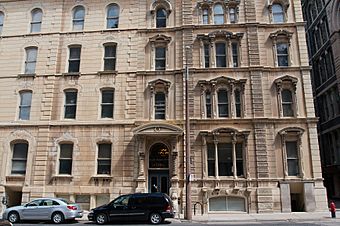State Bank of Wisconsin facts for kids
Quick facts for kids |
|
|
State Bank of Wisconsin
|
|

State Bank of Wisconsin
|
|
| Location | 210 E. Michigan St. Milwaukee, Wisconsin |
|---|---|
| Built | 1856/1858/1903 |
| Architect | Mygatt & Schmidtner/Albert Nash/Ferry & Clas |
| Architectural style | Italian Renaissance Revival |
| NRHP reference No. | 84003742 |
| Added to NRHP | March 8, 1984 |
The State Bank of Wisconsin is a tall, six-story office building in Milwaukee, Wisconsin. It was built in 1906. The building has a special style called Neoclassical. Because it's an important historical place, it was added to the National Register of Historic Places in 1984.
Contents
Building History
Starting Banks in Wisconsin
Back in 1852, people in Wisconsin voted to allow new banks. This vote was called a referendum. It meant that businesses could open banks with a special permission from the state. This permission is known as a charter.
Because of this vote, a new law was made in 1852. This law helped set up many banks. In 1853, a man named Eliphalet Cramer started the State Bank of Wisconsin. Two years later, in 1855, Charles D. Nash started the Bank of Milwaukee. These were two of the fifteen banks that opened in Milwaukee at that time.
The First Bank Buildings
The first building for Cramer's State Bank of Wisconsin began construction in 1856. We are not completely sure who designed it. However, it was probably George W. Mygatt and Leonhardt A. Schmidtner. They worked on other projects for Mr. Cramer.
This first building had an Italian Renaissance Revival style. It had four main floors above a raised basement. The building's frame was made of wood. It was covered with limestone from near Joliet, Illinois. It also had special corner blocks called quoins. A decorative ledge, known as a cornice, stuck out from the top. There was also a cast iron entablature, which is a fancy band of decoration.
Adding the Bank of Milwaukee
Charles Nash's Bank of Milwaukee was built right next door in 1858. His relative, Albert Nash, designed it. This building looked very similar to the State Bank of Wisconsin next to it. However, it had decorative covers over its windows. The two buildings shared a wall between them.
Joining the Buildings
In 1903, a company called Ferry & Clas worked on the buildings. They joined the two separate bank buildings together. Later, in 1956, a part of the building fell down. The damaged areas were rebuilt using some of the old limestone. They also used cream-colored brick to fix it.

